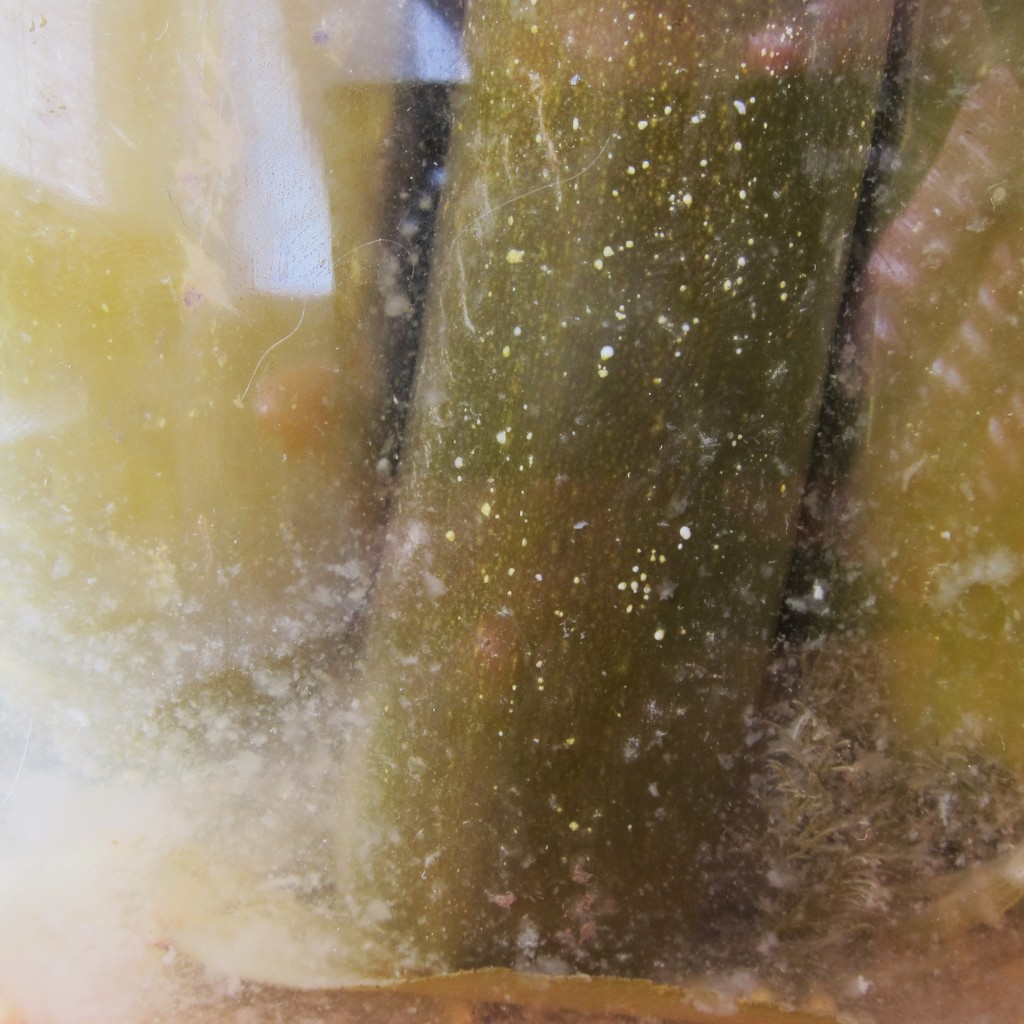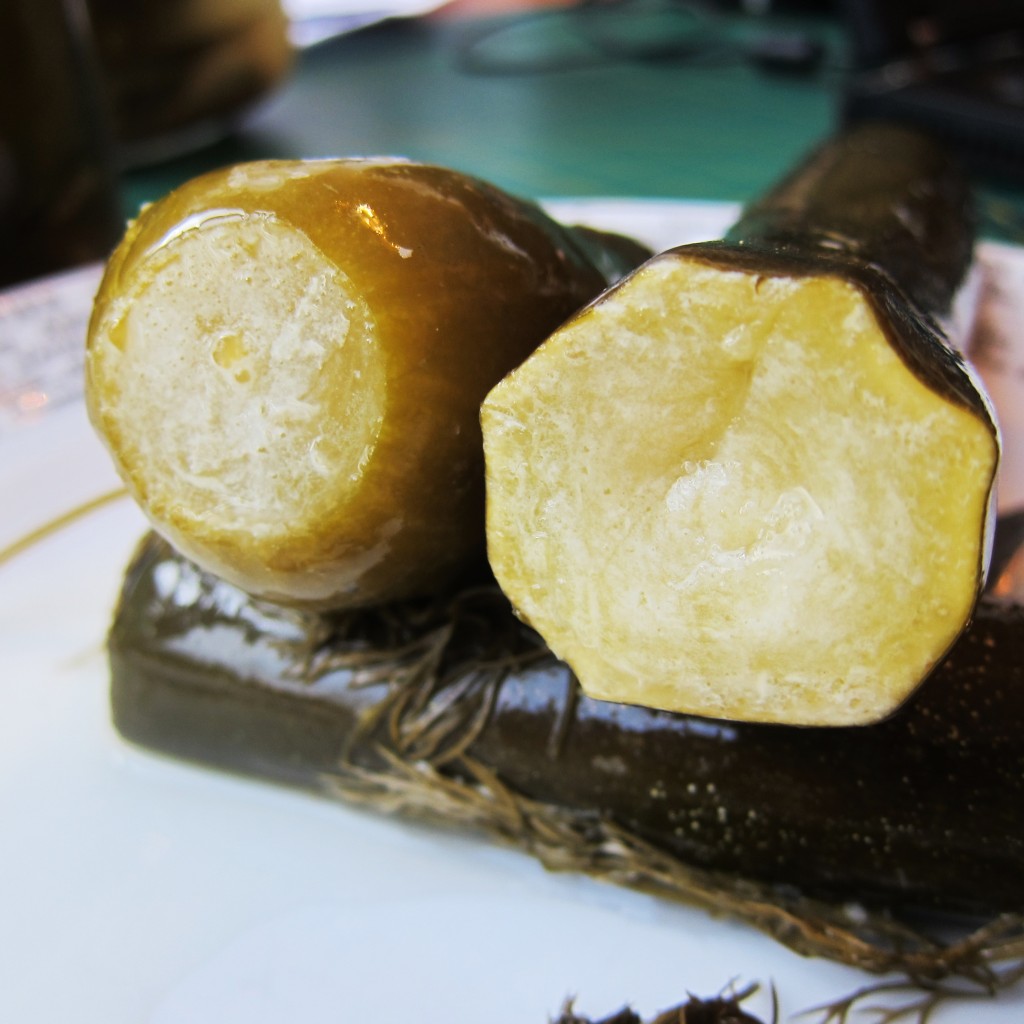It was time to check up on my fermenting pickles. The cloudy water was not encouraging. When I opened up the jars the smell was: garlicky dill with a hint of food-gone-bad. It almost smelled right but really didn’t. I suppose that they might be safe to eat when you consider that people have been burying fish to rot them for eating joy for hundreds of years.
But I am not a person who buries things until they’re rotted just-so. My dog does this. There is nothing finer to her than to bury a bit of rawhide in a good rainy spot, let it acquire a strong odor of dead body, and then dig up the blackened delicacy to eat at my feet.
I don’t know what I did wrong. The cauliflower I fermented two years ago never went bad. I had it in the cupboard for months before we finished it off. I was completely confident in it and we enjoyed eating it. I followed essentially the same process. An acquaintance of mine has suggested they got too warm. This is a very real possibility as September and part of October was pretty hot and there isn’t a truly cool spot in the house to store pickles.
I’m disappointed, obviously. Such a waste of pickling cucumbers. But as with all skills – there is a learning curve and some failures are expected. My olives seem to be doing alright still and I can start a new fermentation project using winter vegetables like cauliflower, carrots, and possibly some greens. My friend Cam suggested fermenting mustard greens like her mom did when she was growing up. She says she’ll see if she can get the recipe for me.
On the bright side of the food preserving front – last night I didn’t want to make dinner. I was too tired. But hungry. So I pulled a jar of my tomato sauce from the pantry and whipped up a super easy and quick marinara sauce and had spaghetti with roasted cauliflower and it was so good! This is why I do all the canning work I do.
Have any fermenting tales to share? I want to hear them!





Is that mold on top? Ha ha- I thought it was fleur de sel! Sorry about your moldy fermentation.
I agree, it probably was the heat. We had too many hot days in October, c’est dommage…
Mold and yeasts often grow on top of ferments, since they have all that air exposure. They are in inherently harmful. The first thing I would check is to make sure that your cucumbers are fully submerged. I’m not sure if you took off the weight for the pictures, but you definitely want to put something on top to keep the cucumbers (or whatever you pickle) completely under the liquid. I use a flexible lid that is smaller than the mouth of the jar. As molds grow, you should also do your best to scrape them off the surface (every day or every other day, depending on how fast they’re growing). They can, if left, affect the flavor of the final pickle. You might be right about the heat issue too. I keep my ferments in my basement and, at that ambient temperature (about 60 degrees), I find cucumber pickles take about 2-2.5 weeks till they are nice and sour. I had problems, when I first started fermenting, with heat. I was leaving my containers in the window (in the south) and they just got too hot. The heat speeds up fermentation and can cause spoilage. You could also up the salt saturation, but that will result in a slower ferment, as well. Hope this helps! I’ve been pickling for well over a year and started doing so commercially a few months ago.
As an aside, pickled dark leafy greens are not everyone’s thing. Think of them like really stinky cheese (re: Limburger). The flavor can be quite good, but due to the high levels of chlorophyll, can also be very strong.
Thanks for the information. I could not find anything to weight them down – this is a problem I have a lot. I wedged them so they stayed under the brine and weren’t exposed but in the picture they are exposed because I moved them around to examine them. A flexible lid sounds like a really good solution – I’ll definitely try that next time! I really do think heat was the culprit. I made a successful batch of fermented cauliflower two years ago – but I was living in Northern Oregon and it is much cooler there so much easier to find cool places to store fermentation projects.
I might not like pickled dark leafy greens but I won’t know until I try them.
I really appreciate your comment – it’s great hearing from other people about their fermenting and to get useful tips on how to be more successful with mine.
Oh yes – that’s mold. I could tell when I opened the jars that the fermenting had gone wrong. You could smell it even if you couldn’t see it. There’s a point in fermenting where it smells bad and that’s fine – but at that stage it should not have smelled like that. Plus – you know – mold should never be on your actual pickle. Oh well. Me and fermentation aren’t done with each other by a long shot. This is like the horrible deflated potato bread I made early on in my bread baking.
I made fermented cauliflower 2 days ago. I put a few spices and fresh crushed garlic inside. I checked on it today and at the bottom of the jar there is a light blue color. I cannot tell if this is mold or if the garlic just turned blue. Sometimes when I cook with garlic and lemon the garlic turns blue/green from the acid. How can I tell if it is okay or not?! I noticed that there is a sour smell to it too (without even opening the jar I could smell it) is this because I used a lacto fermented culture starter?
I’m so sorry that I haven’t responded to this post! It sounds like the culprit of the blue coloration is the garlic. I’ve never used a lacto fermented culture starter but when doing natural fermentation it should go through a period of a couple of weeks of smelling really gross but then, provided it hasn’t gone bad as I showed in this post, your fermented vegetables should lose the foul smell and start to smell pleasantly sour. IF there’s no mold on the food itself it’s probably safe to eat. If there’s mold on the surface of the brine you can skim it off and as long as the food hasn’t got mold on it then it should be safe to eat.
Hello, good stories. Need all the insight and help I can get. I just love the idea of fermenting foods. I just made a small batch of dill pickles and I think I used too much salt. I opened after one week and lots of bubbles. I was excited and thought it was going well. I left in another week and refridgerated them. They have been in the fridge for two weeks and I just ate one slowly. I am very nervous of botulism or mold and getting sick, but I am eager to eat them and begin fermenting more. The pickles needed more dill and less salt but they have almost like a german beer smell too them outside the dill and salt. I guess Ill know tommorrow but if anyone is interesting in helping me or exchanging stories etc. let me know. I live in Northern Illinois Thanks and good luck.
David – the risk of botulism with fermenting is very low. If your pickle is slimy or moldy, though, don’t eat it. As Patrick points out – mold forming on the top of the brine is normal and should be removed frequently. But mold on the actual pickle is NOT normal, don’t eat it.
Looking at your pictures, that white layer seems to me to look more like Kahm yeast. Kahm yeast stays in a flat, scummy sort of layer, breaking into flecks at times or getting stringy while mold is raised and fuzzy. Kahm yeast does not smell good and does not taste good in large amounts, but it is harmless. I have dealt with it more times than I would prefer on pickle ferments and lacto-sodas. I believe that a high ferment temperature and an imbalance of acids is at fault, but do check out http://phickle.com/the-wrath-of-kahm/
His article is great.
Thank you for the information. I’m not especially afraid of mold or yeasts but these pickles also turned to a disgusting mush so I wasn’t interested in eating them anyway.